Yoruba Beaded Cushion, 1939 CE
Leather, Beads
15.5 x 6.5
PF.4978B (LSO)
Further images
This colourful piece is a beaded cushion/footstool made by the Yoruba of Nigeria. It is a low, circular piece, liberally adorned with beads. The inscription – written into the superior...
This colourful piece is a beaded cushion/footstool made by the Yoruba of Nigeria. It is a low, circular piece, liberally adorned with beads. The inscription – written into the superior rim of the object – details the name of the Oba in question (Kabiyesi) and some other information including the date of manufacture, or perhaps the Oba’s date of accession/birth. The top is decorated with floral and geometric motifs, while the sides are adorned with faced, perhaps representing the guardian spirit Eshu.
The Yoruba nation state is comprised of numerous subsections that were joined historically by the rise and collapse of the Ife (12th to 15th centuries) and Benin (13th to 19th centuries) polities. The Yoruba are sedentary, agriculturist and hierarchical, and are ruled by hereditary kings known as Obas. Each of the sub-kingdoms – including Oyo, Ijebu and smaller units towards the west – had their heyday, and are loosely united through language and culture, while still retaining a measure of independence in terms of artistic and religious tradition.
The Yoruba therefore possess one of the most ancient artistic heritages in Africa, most of which is designed to thwart evil spirits, and to placate or honour those that bring good fortune to the populace. Access to the supernatural world is supervised by a very complex arrangement of priests and spiritual intermediaries, who straddle the cosmological border between the tangible realm of the living (aye) and the invisible realm of the spirits and the hereafter (orun). The creator of the world is Olodumare – the source of all ase (life force) – and his spiritual minions include all manner of spirits, gods and ancestors who can be appealed to or appeased through diviners and other holy men (babalawo).
The Oba would always manifest his power with the use of regalia and other impressive paraphernalia, such as this. The name Kabiyesi is still in use today by aristocratic families of Nigeria, such as Kabiyesi Oba Gbenga Sonuga, Fadesewa of Simawa. The level of detail and quality of work is spectacular, as befits a king who is technically a god in the eyes of his people. This is an important piece of African art.
The Yoruba nation state is comprised of numerous subsections that were joined historically by the rise and collapse of the Ife (12th to 15th centuries) and Benin (13th to 19th centuries) polities. The Yoruba are sedentary, agriculturist and hierarchical, and are ruled by hereditary kings known as Obas. Each of the sub-kingdoms – including Oyo, Ijebu and smaller units towards the west – had their heyday, and are loosely united through language and culture, while still retaining a measure of independence in terms of artistic and religious tradition.
The Yoruba therefore possess one of the most ancient artistic heritages in Africa, most of which is designed to thwart evil spirits, and to placate or honour those that bring good fortune to the populace. Access to the supernatural world is supervised by a very complex arrangement of priests and spiritual intermediaries, who straddle the cosmological border between the tangible realm of the living (aye) and the invisible realm of the spirits and the hereafter (orun). The creator of the world is Olodumare – the source of all ase (life force) – and his spiritual minions include all manner of spirits, gods and ancestors who can be appealed to or appeased through diviners and other holy men (babalawo).
The Oba would always manifest his power with the use of regalia and other impressive paraphernalia, such as this. The name Kabiyesi is still in use today by aristocratic families of Nigeria, such as Kabiyesi Oba Gbenga Sonuga, Fadesewa of Simawa. The level of detail and quality of work is spectacular, as befits a king who is technically a god in the eyes of his people. This is an important piece of African art.
Literature
V30











